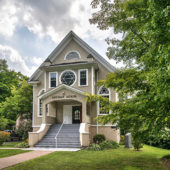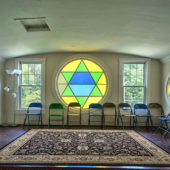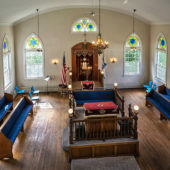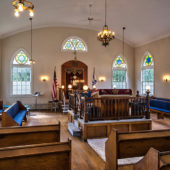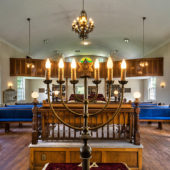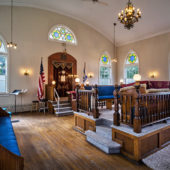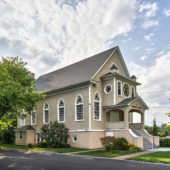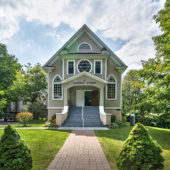On both the New York and National Registers of Historic Places, designed by a congregant based on his memories of synagogues in Eastern Poland.
Congregation Agudas Achim has graciously provided its history to this website:
The History of Agudas Achim
In 1909, Max Schwartz, a butcher, became the first Jewish resident of Livingston Manor. It was a thriving community with farms, lumbering and a factory that made bowling pins. Months later, Max Sorkin brought his family here. Within the next few years, more Jewish families arrived to become merchants and farmers. The Adler, Siegel, Strauss, Weiner, Resnick, Meyerson, Moskowitz, Nelson, Wittenberg, Newman, Kahn, Steinman, Friedman, Brandt, Silverman and Brooks families were soon followed by the Fishman, Colin and Keiser families. These families overcame local resistance and anti-Semitism by being good neighbors and making significant contributions community life.
The Jewish community in Livingston Manor organized into distinct groups, The Avodah Synagogue, an observant Orthodox group that worshipped in a pavilion on Sherwood Island and a more secular and culturally Yiddish speaking group affiliated with the Sholem Aleichem Folkshuls. They built a structure on Pearl Street that later became the American Legion Hall and then Community Center building. There were also social welfare groups like the Jewish Farmers Society and Jewish Welfare Club.
Agudas Achim (gathering of brothers) was organized in 1913 began as a burial society for the entire community. They purchased a beautiful parcel of land on Morsston Hill overlooking the Little Beaverkill as a cemetery. In order to accommodate the growing Jewish community, a building lot was purchased in 1922. Max Brooks designed the building based on his memory of the synagogues in the Eastern Poland of his youth. Working with his son, Isaac construction began in 1924. The building opened for worship in 1925 as all the diverse groups merged into a single congregation. Many of the early members were not strongly observant, however the religious practices in the synagogue were strictly Orthodox.
By the 1930’s, many of the farming families began taking in summer boarders and these farms became the hotels which were the backbone of the local economy for decades to come. The largest among them were the Waldemere, White Roe Lake, Trojan Lake Lodge, Edgewood Inn, Parkston House and Capitol. Members of Agudas Achim owned and operated these hotels and the Jewish community remained vibrant and strong into the 1960’s. The synagogue was then both a social and cultural hub of Livingston Manor. The Ladies Aid Society was responsible for much of that activity, led by women like Jean Weiner, Shirley Schwartz, Marge Siegel, Shirley Newman, Evelyn Haas, Bobbie Foster, Lynn Schwartz, Lillian Fishman, Sophie Jacobs, Belle Schwartz and Susan Fishman. Their annual Brotherhood Dinner was supported by the entire community.
By the late 1960’s, it was no longer practical to hire a Rabbi and support a Hebrew school as Jewish population declined. Yet the core of the community, led by Lee Siegel, along with Jack Fishman, Alan Fishman, Mack Weiner and George Silverman remained committed to keeping the synagogue alive. There were always High Holy Day services held at Agudas Achim though the building was closed the rest of the year.
Around 1980 several young people from Livingston Manor’s long time Jewish families, and some new to the community, sought to enrich and enliven their Jewish presence here. With the Agudas Achim synagogue as their foundation, and Lee Siegel as a mentor, Bob and Lynne Freedman, Alan, Fishman, Ellen Singer and Don Simkin, Judy (Haas) and Gary Siegel explored affiliation with the Reform movement. Agudas Achim was reborn as a Reform congregation, with a deep respect for tradition. In 1986 we joined the Union for Reform Judaism after working several years with Rabbi Daniel Freelander, who is currently Executive Vice President of the URJ, for several years.
Regular monthly Sabbath services and holiday celebrations were added to the High Holy Day worship. A revitalized religious school now teaches our youth an appreciation of their heritage and prepares them for Bar and Bat Mitzvah. In 2004 Rabbi Fred Pomerantz was hired to lead the congregation. His many years as a congregational Rabbi has provided us with the inspiration and guidance needed to create a vital sustainable community despite our small numbers. Our community was enriched when Ahavath Shalom of Jeffersonville began the process of becoming part of Agudas Achim in 2010.
In 2013 celebrated the 100th Anniversary of Agudas Achim. The celebration included a grand banquet attended by over 150 people at which we recognized Bob Freedman and Ellen Singer for their special role in creating our modern congregation. Danny Maseng, after leaving Agudas Achim became a world famous musician, teacher and scholar presented a scholar-in-residence weekend which reignited our spirit.
Agudas Achim has attracted members from all of parts Sullivan County and surrounding areas because of its openness and welcoming spirit. The guidance of outstanding spiritual leaders, who included Rabbi Moshe Halfon, Rabbi Robert Jacobs, Rabbi Peter Schaktman, Danny Maseng, who helped shape the modern Agduas Achim community.
Due to the efforts of Maurie Sachs, Agudas Achim was named to both the National and New York State Register of Historic Places in 1999. In 2005, the synagogue embarked on an ambitious restoration project raised over $80,000. The results stand here as testimony of our appreciation for the experiences of previous generations and our commitment to the future. These efforts were recognized in 2006 by Sullivan Renaissance as the winner in the Historic Preservation category. An article by Ben Halpern about our history appeared in the NYS Folklore Journal during our centennial. In 2015, we were selected to be part of the Synagogues 360 project of Beit Hatfutsat, The Museum of the Jewish People, in Tel Aviv because of its significant architecture and the success we have experienced in preserving a rural Jewish community which would have disappeared.
Agudas Achim, in the 21st century, continues to stand as a unique welcoming outpost of Jewish life in the Catskills. By continuing the tradition of gathering Jews of many backgrounds, Agudas Achim will survive as an integral and vibrant part of the greater Livingston Manor and Sullivan County community.

